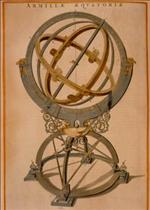Imagine the sky as the inside surface of an enormous sphere. Earth floats in the center of this sphere so that its spin axis aligns with the North and South Celestial Poles. Earth’s equator, projected onto the sphere, becomes the celestial equator; lines of declination in the sky match up with parallels of earthly latitude. A 15° span of the celestial equator equals the sky’s westward motion in one hour of time, and thus one hour of right ascension. Astronomers measure right ascension eastward along the celestial equator, starting from the Sun’s position at the spring equinox (also known as the “first point in Aries”).
If we viewed the sky from Earth’s equator, the celestial poles would lie on the horizon and the celestial equator would arc directly overhead, passing through the zenith. This orientation makes the celestial sphere a “right sphere,” one in which the horizon meets the celestial equator at 90°. The stars now rise at a right angle to the horizon, and all objects on the same arc of right ascension rise together.
But suppose we move away from Earth’s equator. Now the celestial equator meets the horizon at an oblique angle, that is, one other than 90°. Astronomers once referred to “oblique ascension,” an angle measured along the celestial equator from the spring equinox to where a point of interest meets the horizon. The term is now used so rarely that many professional astronomers have never heard of it. Oblique ascension refers positions to the horizon, so a given value applies only to observers at the same latitude, whereas right ascension describes sky positions for any observer on Earth.
While “ascension” refers to rising stars, astronomers once also used right and oblique “descensions” based on setting stars. Today, only right ascension survives in astronomy, although the other terms find occasional use in astrology texts.
We thank James Hilton of the U.S. Naval Observatory and Brent Archinal of the U.S. Geological Survey for their help in answering this question. — FRANCIS REDDY, ASSOCIATE EDITOR










